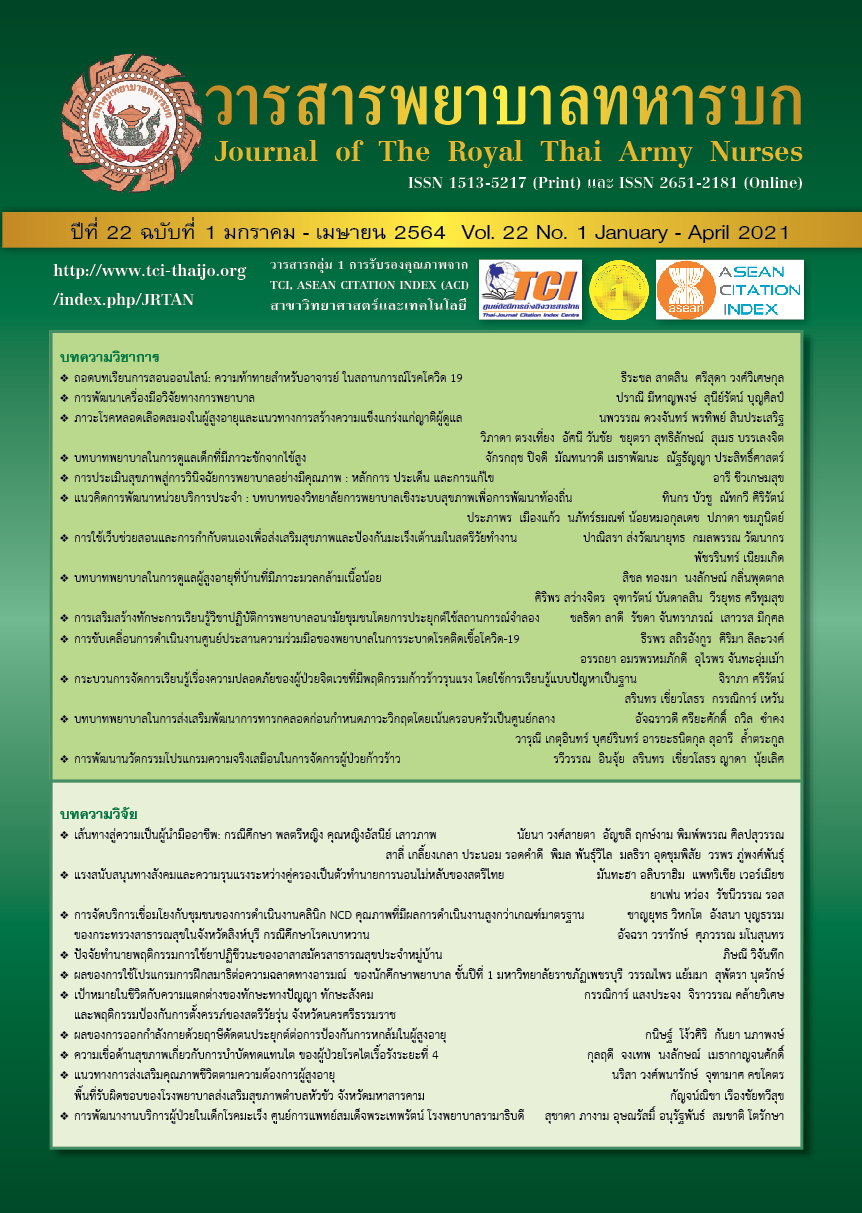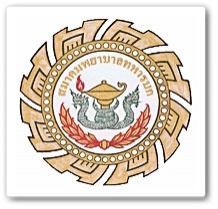Using Web-Based Instruction and Self-regulation to Health Promotion and Prevention Breast Cancer in Working Women
Keywords:
web-based instruction, self-regulation, health promotion, breast cancer, working womenAbstract
Promoting breast cancer prevention among working women is essential in order not to be fatal. Nurses play an important role in promoting breast cancer prevention health in working women by using the web site instruction and Bandura's self-regulatory theory. There are 4 steps: Step 1: Assess and enhance understanding. Step 2: Develop skills. Step 3 Decide and set goals, and step 4 self-regulation and reinforcement. It helps working women to understand themselves. Web-site instruction helps improve knowledge, demonstrations, practice skills in behavior modification with continuous monitoring via LINE or Facebook to exchange and learn from experience. It helps to boost morale and understanding behavioral
practices, help working women to find solutions to problems together, apply new knowledge to the point of practicing, and changes lifestyle until able to reduce the risk of breast cancer in the future.
Downloads
References
Sharma R. Breast cancer incidence, mortality and mortality -to-incidence ratio (MIR) are associated with human development, 1990-2016: evidence from global burden of disease study 2016: evidence from global burden of disease study 2016. Breast Cancer 2019. 2019; 26: 428-45.
Khuhaprema T, Attasara P, Sriplung H, Wiangnon S, Sangrajrang S. (eds). Cancer in Thailand Vol. VII 2007- 2009. Bangkok: Bangkok Medical Publisher; 2013. (in Thai)
Bray F, Ferlay J, Soerjomataram I, Siegel RL, Torre LA, Jemal A. Global cancer statistics 2018: GLOBOCAN estimates of incidence and mortality worldwide for 36 cancers in 185 countries. CA Cancer J Clin. 2018; 68: 394-424.
Virani S, Bilheem S, Chansaard W, Chitapanarux I, Daoprasert K, Khuanchana S, et al. National and subnational population-based incidence of cancer in Thailand: assessing cancers with the highest burdens. Cancers. 2017; 9: E108.
Saeedi-Saedi H, Shahidsales S, Koochak-Pour M, Sabahi E, Moridi I. Evaluation of emotional distress in breast cancer patients. Iran J Cancert Prev. 2015; 8(1): 36-41.
Haghighi F, Khodaei S, Sharifzade GR. Effect of logotherapy group counseling on depression in breast cancer patients. Modern Care Journal. 2013; 9(3): 165-172.
Phunthong S, Kasiphol T, Prasertsong C. The Relationships between Family Support and Well Being among Patients with Breast Cancer on going Chemotherapy. Journal of The Royal Thai Army Nurses. 2019; 20(1): 165-171. (in Thai)
Kaewphanna S, Wirojratana V, Chanruangvanic W. The relationships between patient’s health status, mutuality, preparedness, and caregiver role strain in caregivers of older persons with advanced cancer receiving palliative care. Journal of The Royal Thai Army Nurses. 2020; 21(1): 183-192. (in Thai)
Lamieian M, Heydarnia AR, Ahmadi F, Faghihzadeh S, Aguilar VM. Women’s prospect of breast cancer early detection behavior. A qualitative research. 2008; 15(3): 88-102.
Mahon SM. Site-specific cancer series: Breast cancer, 2nded., Oncology Nursing Society, Pittsburgh, PA; 2011.
Tritipsombut J. The relationships between knowledge, health perception and breast cancer preventive behaviors in risk group women, The 7th Khon Kaen Disease Control Office. 2019; 10(2): 141- 50. (in Thai)
Thanes P. Fight breast cancer to stay flea. Nonthaburi: Baan Rak Publishing; 2012 (in Thai)
Hardefeldt JP, Penninkilampi R, Edirimanne S, Eslick DG. Physical activity and weight loss reduce the risk of breast cancer: A meta-analysis of 139 prospective and retrospective studies. Clinical Breast Cancer. 2017; 18(4), e601-e612.
Kya HH, Bachman FV, Alexander TL, , Mumford EJ, Afshin A, Estep K., et al., Physical activity and risk of breast cancer, colon cancer, diabetes, ischemic heart disease, and ischemic stroke events: systematic review and dose-response meta- analysis for Global Burden of Disease Study 2013. Br. Med J. 2016; 354: i3857.
Guinan EM, Connolly EM, HusseyJ. Exercise training in breast cancer survivors: a review of trials examining anthropometric and obesity-related biomarkers of breast cancer risk. Phys Therapy Rev. 2013; 18(1): 79-83.
Irwin LM, McTiernan A, Manson EJ, Thomson AC, Sternfeld B, Stefanick LM., et al., Physical activity and survival in postmenopausal women with breast cancer: results from the women’s health initiative. Cancer Prevent Res. 2011; 4(4): 522-29.
Scott E, Daley AJ, Doll H, Woodroofe N, Coleman RE, Mutrie N, et al. Effects of an exercise and hypocaloric healthy eating program on biomarkers associated with long-term prognosis after early-stage breast cancer: a randomized controlled trial. Cancer Causes Control. 2012; 24(1): 181-91.
Pudkasam S, Tangalakis K, Chinlumprasert N, Apostolopoulos V., Stojanovska L. Breast cancer and exercise: The role of adiposity and immune markers. Maturitas. 2017; 105: 16-22.
Taylor VH, Misra M, Mukherjee SD. Is red meat intake a risk factor for breast cancer among premenopausal women? Breast Cancer Res Treat. 2009; 117: 1-8.
Bray F, Ferlay J, Soerjomataram I, Siegel RL, Torre LA, Jemal A. Global cancer statistics 2018: GLOBOCAN estimates of incidence and mortality worldwide for 36 cancers in 185 countries. CA Cancer J Clin. 2018; 68: 394-424.
Cao Y, Willett WC, Rimm EB, Stampferir JM, Giovannucci LE. Light to moderate intake of alcohol, drinking patterns, and risk of cancer: results from two prospective US cohort studies. BMJ. 2015; 351: h4238.
Chu L, Wallach D J. Consideration of confounding in epidemiologic studies assessing alcohol consumption on the risk of breast cancer: A brief report. Chemico-Biological Interactions. 2020; 322: 109060.
Dianatinasab M, Fararouei M, Mohammadianpanah M, Zare-bandamiri M, Rezaianzadeh. Hair coloring, stress, and smoking increase the risk of breast cancer: A case-control study. Clinical Breast Cancer. 2017; 17(8): 650-659.
Sannes TS, Dolan E, Albano D, Ceballos MR, Mc Gregor AB. Stress management reduces intraindividual cortisol variability, while not impacting other measures of cortisol rhythm, in a group of women at risk for breast cancer. Journal of Psychosomatic Research. 2015; 79: 412-19.
Crew D K, Silverman TB, Vanegas A, Trived SM, Mata J, Sin M, et al. Study protocol: Randomized controlled trial of web-based decision support tools for high-risk women and healthcare providers to increase breast cancer chemoprevention. Contemporary Clinical Trials Communications. 2019; 16(100433): 1-9.
Gange RM, Briggs LJ, Wager WW. Principles of instructional design. (4ed.). Fort Worth: TX, Harrcourt Brace Jovanovich College Publishers; 1992.
Bandura A. Social foundation of thought and action. New Jersey: Prentice-Hall; 1986.
Poomsanguan K & Prajankett O. Self care, self regulation and self efficacy behavior of military officials who had risk of metabolic syndrome. Journal of The Royal Thai Army Nurses. 2017;18(3): 107-114. (in Thai)
Yaisoon s, Cheewapat P, Budsaengdee B. Developing Self-Regulation Model of Pre-Service Skills Training in Practicuum in Family Nursing and Midwifery I course of Nursing Students in Srisavarindhira Thai Red Cross Institute of Nursing. Journal of The Royal Thai Army Nurses. 2019; 20(3): 133-143. (in Thai)
Seesawang J, Songwatthanayuth P. The effectiveness of supportive-educative program on knowledge, attitude, and skill of self breast examination among women. Journal of The Royal Thai Army Nurses. 2013; 14(1): 17-24. (in Thai)
Patdeewong N, Komompapat N. Knowledge, health belief, self-efficacy and breast self-examination among female students receiving breast self-examination enhancing program. Association of Private Higher Education Institutions of Thailand. 2018; 7(1): 57-70. (in Thai)
Tumwijit S, Tongvichean S, Chitthathairatt S, Iblas SA. The effectiveness of interventions for improving breast self-examination behaviours among adult women: A systematic review and meta-analysis. Journal of The Royal Thai Army Nurses. 2019; 20(3): 124-32. (in Thai)
Thorat AM, Balasubramanian R. Breast cancer prevention in high-risk women. Best Practice & Research Clinical Obstetrics and Gynecology. 2020; 65: 18-31.
Downloads
Published
How to Cite
Issue
Section
License
บทความหรือข้อคิดเห็นใดใดที่ปรากฏในวารสารพยาบาลทหารบกเป็นวรรณกรรมของผู้เขียน ซึ่งบรรณาธิการหรือสมาคมพยาบาลทหารบก ไม่จำเป็นต้องเห็นด้วย
บทความที่ได้รับการตีพิมพ์เป็นลิขสิทธิ์ของวารสารพยาบาลทหารบก
The ideas and opinions expressed in the Journal of The Royal Thai Army Nurses are those of the authors and not necessarily those
of the editor or Royal Thai Army Nurses Association.






